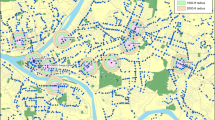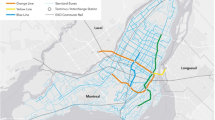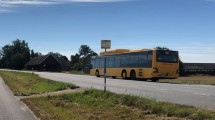Abstract
Bus transit route frequencies in practice are often set reactively, without consideration of ridership elasticity to the service frequency provided. Where elasticities are used in frequency allocation, a single across the board value or two respective values for peak and off-peak are used for the entire set of routes and stops throughout the day. With growing availability of ridership data, estimation of spatially and temporally disaggregated elasticities is possible. But do these make a difference in the resulting solution to the frequency allocation problem? This study is intended to examine this question by comparing the quality of solutions obtained using an optimal frequency allocation model with different sets of elasticities corresponding to varying levels of disaggregation. Three main methodologies for estimating ridership elasticity with respect to headway are compared in the context of a transit network frequency setting framework: (1) temporal elasticities based on time of day, (2) spatial elasticities via grouping stops into demand, supply and land use classes and (3) spatio-temporal elasticities using a linear regression model. Elasticities based only on temporal aggregation result in an underestimation of the potential improvements as compared to elasticities which account for some spatial characteristics, such as land use and the opportunity to transfer. It is also important to capture longer-term effects—over a year or more—because seasonal activity patterns may bias elasticity estimates over shorter time horizons.





Similar content being viewed by others
References
Balcombe R (2004) The demand for public transport: a practical guide. TRL Report TRL593
Byrd RH, Nocedal J, Waltz RA (2006) KNITRO: an integrated package for nonlinear optimization. In: Pillo G, Roma M (eds) Large-scale nonlinear optimization, vol 83 of Nonconvex optimization and its applications. Springer, New York, pp 35–59
Chen C, Varley D, Chen J (2011) What affects transit ridership? A dynamic analysis involving multiple factors, lags, and asymmetric behavior. Urban Stud 48(9):1893–1908. doi:10.1177/0042098010379280
Fan W, Machemehl RB (2006) Optimal transit route network design problem with variable transit demand: genetic algorithm approach. J Transp Eng 132(1):40–51. doi:10.1061/(ASCE)0733-947X(2006)-132:1(40
Frei C, Mahmassani HS (2013) Riding more frequently: disaggregate ridership elasticity estimation for a large urban bus transit network. Transp Res Rec (in press)
Furth PG, Day FB (1985) Transit routing and scheduling strategies for heavy demand corridors. Transp Res Rec 1011:23–26
Furth PG, Wilson NHM (1981) Setting frequencies on bus routes: theory and practice. Transp Res Rec 818:1–7
Gallo M, Montella B, D’Acierno L (2011) The transit network design problem with elastic demand and internalisation of external costs: an application to rail frequency optimisation. Transp Res Part C 19(6):1276–1305. doi:10.1016/j.trc.2011.02.008
Guihaire V, Hao JK (2008) Transit network design and scheduling: a global review. Transp Res Part A 42(10):1251–1273. doi:10.1016/j.tra.2008.03.011
Lin LIK (1989) A concordance correlation coefficient to evaluate reproducibility. Biom 45(1):255–268
Litman T (2004) Transit price elasticities and cross-elasticities. J Public Transp 7(2):37–58
Taylor BD, Miller D, Iseki H, Fink C (2009) Nature and/or nurture? Analyzing the determinants of transit ridership across US urbanized areas. Transp Res Part A 43(1):60–77. doi:10.1016/j.tra.2008.06.007
Transit Cooperative Research Program (2004) Transit scheduling and frequency. In: TCRP Rep 95, Traveler response to transportation system changes handbook. http://onlinepubs.trb.org/onlinepubs/tcrp/tcrp_rpt_95c9.pdf. Accessed 6 Feb 2013
Verbas IO, Mahmassani HS (2013) Optimal allocation of service frequencies over transit network routes and time periods: formulation, solution and implementation using bus route patterns. Transp Res Rec (in press)
Walk score methodology (2013) http://www.walkscore.com/methodology.shtml. Accessed 5 July 2013
Zhao F, Zeng X (2008) Optimization of transit route network, vehicle headways and timetables for large-scale transit networks. Eur J Oper Res 186(2):841–855. doi:10.1016/j.ejor.2007.02.005
Acknowledgments
This paper is based in part on research performed under a study supported by the Chicago Transit Authority (CTA). The work has benefited from suggestions and feedback provided by Professor Joseph Schofer, Dr. Hamed Alibabai and Mr. Breton Johnson. The authors are grateful to Mr. Paras Bhayani, Ms. Heather Ferguson, Mr. Mike Connelly, Mr. Alex Cui and Mr. Scott Wainwright at the CTA for their helpful cooperation and comments on various aspects of the study. However, the authors remain solely responsible for all material, results, views or opinions expressed in this paper.
Author information
Authors and Affiliations
Corresponding author
Rights and permissions
About this article
Cite this article
Verbas, İ.Ö., Frei, C., Mahmassani, H.S. et al. Stretching resources: sensitivity of optimal bus frequency allocation to stop-level demand elasticities. Public Transp 7, 1–20 (2015). https://doi.org/10.1007/s12469-013-0084-6
Published:
Issue Date:
DOI: https://doi.org/10.1007/s12469-013-0084-6




